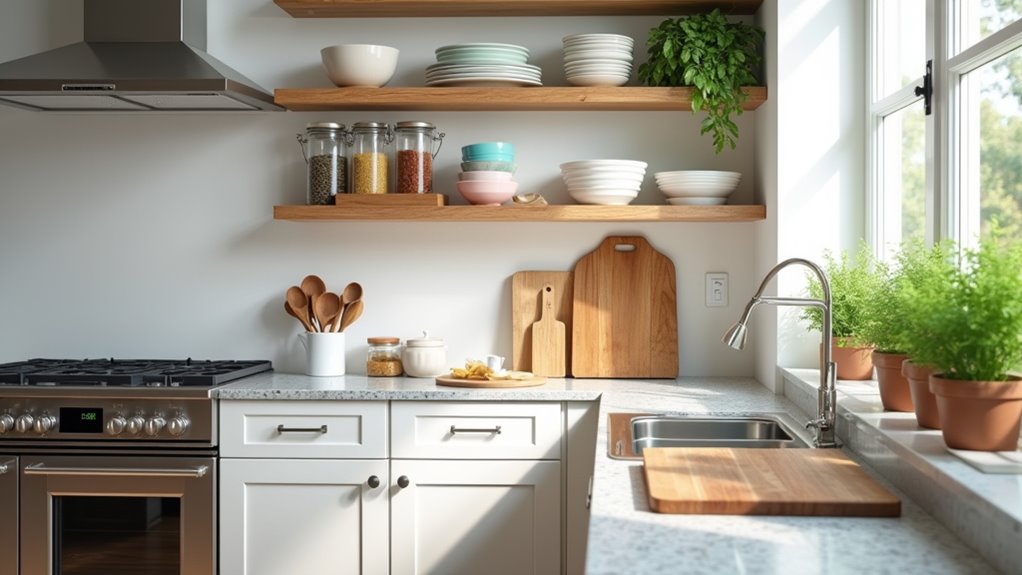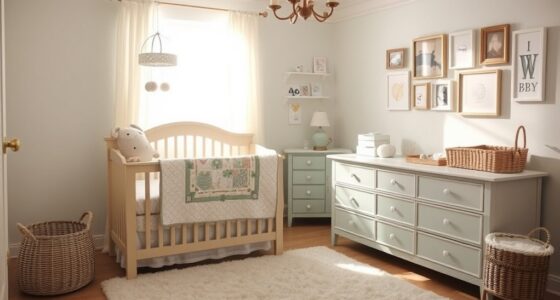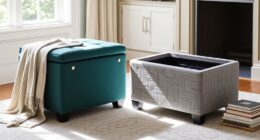To organize your kitchen like a pro, start by assessing your current layout and defining goals for both functionality and aesthetics. Maximize space utilization by decluttering and purging items you no longer use. Focus on organizing key zones for cooking, preparation, and cleaning to improve efficiency. Incorporate smart storage solutions and establish maintenance routines to keep order. Continuously adapt your organization system to suit your evolving cooking needs and lifestyle. Discover more strategies to elevate your kitchen organization.
Key Takeaways
- Assess your kitchen layout and implement the work triangle principle for efficient workflow between the refrigerator, sink, and stove.
- Define essential cooking zones and equip each with task-specific tools to streamline your kitchen activities.
- Declutter regularly by categorizing items to keep, donate, or recycle, maintaining a tidy kitchen environment.
- Utilize storage solutions like drawer dividers, wall shelves, and mobile carts to maximize space and accessibility.
- Continuously adapt your organization systems and reassess your inventory to reflect changing cooking habits and lifestyle needs.
Assessing Your Current Kitchen Layout
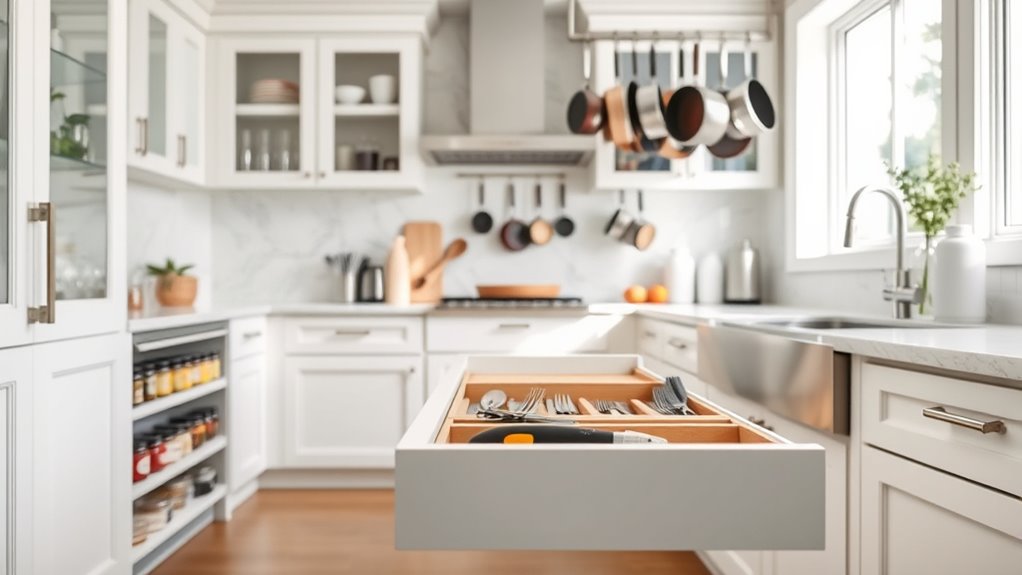
When you assess your current kitchen layout, it's essential to consider how effectively your space meets your cooking and entertaining needs.
Start by evaluating the layout type—whether it's one-wall, galley, L-shaped, U-shaped, island, or peninsula. Measure your kitchen dimensions to identify the best fit.
Evaluate your kitchen layout type—whether one-wall, galley, L-shaped, U-shaped, island, or peninsula—and measure your space for the best fit.
Analyze your workflow: how you move between prep, cooking, and cleanup zones can significantly impact efficiency. Position appliances to minimize movement and enhance functionality. Implementing the work triangle principle helps ensure that your refrigerator, sink, and stove are conveniently located for ease of use. A well-planned layout can also reduce stress levels, promoting a more enjoyable cooking environment.
Don't forget about storage; assess your needs to ensure cabinets are organized and accessible. By strategically placing frequently used items within reach, you'll streamline your cooking experience.
A well-organized layout caters not just to functionality but also to your personal lifestyle and preferences, making your kitchen a more enjoyable space.
Setting Goals for Functionality and Aesthetics
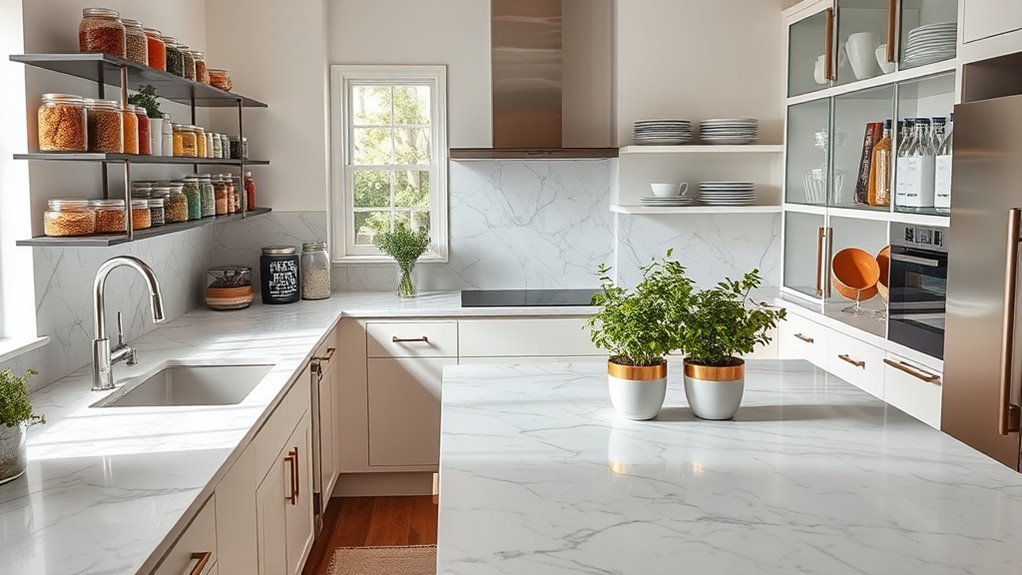
After evaluating your current kitchen layout, it's time to set specific goals that enhance both functionality and aesthetics.
Start by defining essential zones for cooking, baking, and meal prep to streamline your workflow. Prioritize frequently used items by keeping them within easy reach and consider using clear containers and labels for better visibility. It's also beneficial to use stackable containers to optimize vertical space and keep your kitchen organized. Incorporating natural materials like wood can add warmth and character to your kitchen.
Next, choose a harmonious color scheme that complements your decor while opting for stylish storage solutions that blend function with visual appeal. Incorporate natural elements like wood or bamboo to elevate the aesthetic, and remember to minimize clutter by keeping countertops clear.
Finally, add decorative touches, such as plants or artwork, to create a warm, inviting atmosphere in your kitchen.
Maximizing Space Utilization
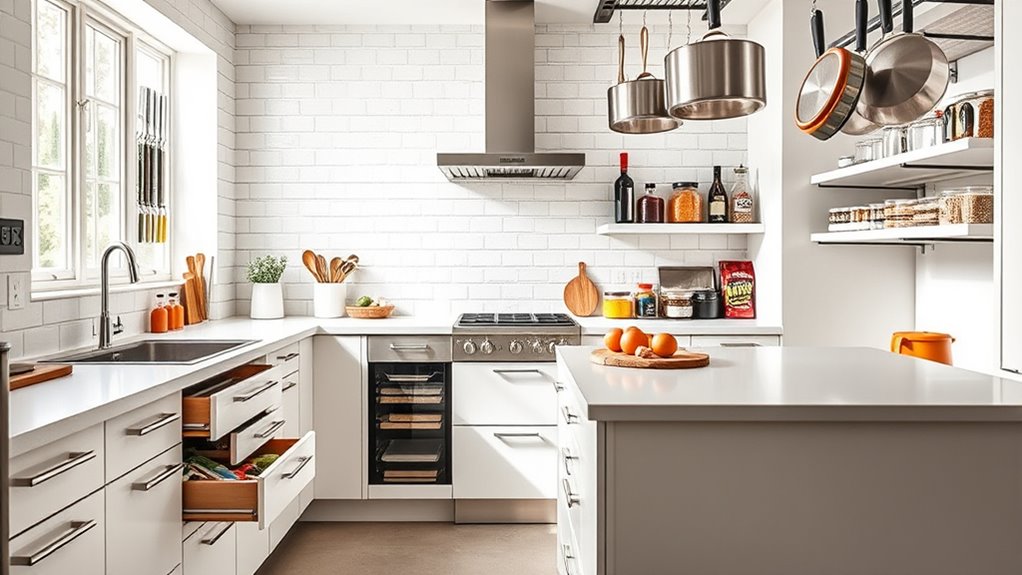
To make the most of your kitchen space, consider a variety of strategies that enhance both storage and workflow.
Start by utilizing wall shelves and corner shelves to free up valuable counter space. Install hanging racks for pots and utensils, and use magnetic strips for knives and spices to save drawer space. One effective way to enhance efficiency is by boarding up the sink to extend your countertop space. Additionally, natural materials like bamboo can add both beauty and functionality to your kitchen storage solutions.
Mobile carts and pull-out surfaces can create flexible work areas, while under-sink storage optimizes often-overlooked areas.
Implement drawer dividers and cabinet organizers to keep items accessible and tidy. Make use of gaps between the fridge and wall with rolling storage units, and remember to utilize cabinet tops for seldom-used items.
Decluttering and Purging Unused Items

Tackling clutter in your kitchen can transform it into a more functional space. Start by assessing cluttered areas and categorizing items into groups like excess coffee mugs, souvenir cups, or unused bakeware. Creating a clutter-free kitchen enhances food prep speed, enabling you to work more efficiently.
Assessing and categorizing clutter can turn your kitchen into a more functional and organized space.
Create a checklist to guide your decluttering tasks. Begin with a top-to-bottom approach, removing everything from surfaces and cabinets. Sort items into "keep, trash, donate, recycle" piles.
Use trash bags for disposal and storage bins for organization. Clean each area thoroughly before returning items, grouping similar ones together.
Schedule regular decluttering sessions to maintain order. Teach family members where items belong and adopt a "one in, one out" policy for new items.
With these strategies, you'll keep your kitchen clutter-free and efficient.
Organizing Kitchen Zones for Efficiency
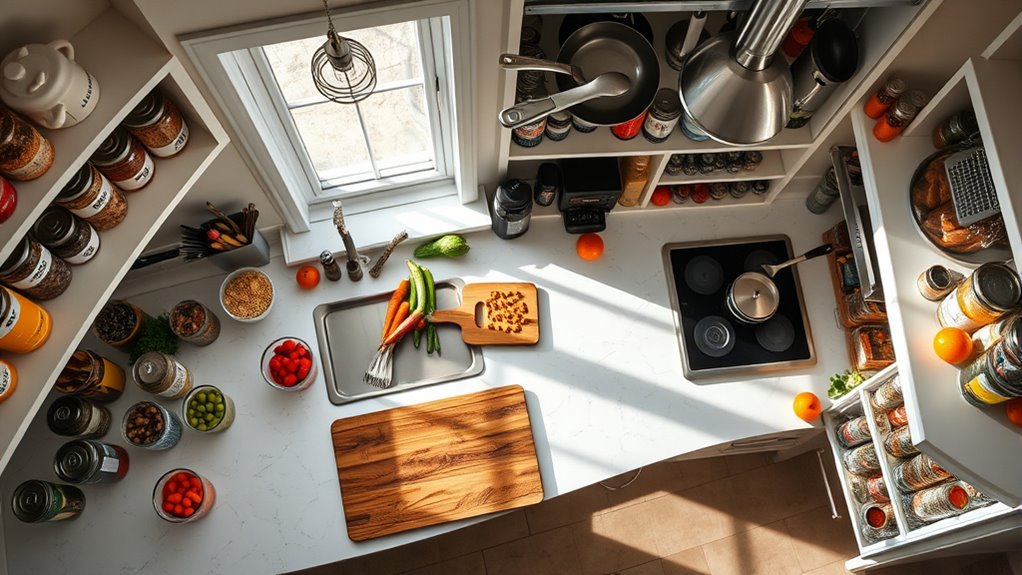
Once you've decluttered and purged unused items, it's time to focus on organizing your kitchen zones for maximum efficiency.
Start by identifying key zones: cooking, preparation, consumables, cleaning, and serving. Position these zones to minimize walking distance while ensuring that related zones are nearby.
Equip each zone with task-specific tools and keep frequently used items within easy reach to streamline your workflow. Organizing the food preparation zone helps ensure that you have everything you need at your fingertips, which promotes a clean and clutter-free workspace. Avoid overlapping zones to maintain clarity and efficiency.
Customize your layout based on your cooking habits and regularly assess the effectiveness of each zone. Adjust as needed to adapt to changing kitchen uses, and remember to return items to their designated zones to keep everything organized and functional.
Implementing Smart Storage Solutions
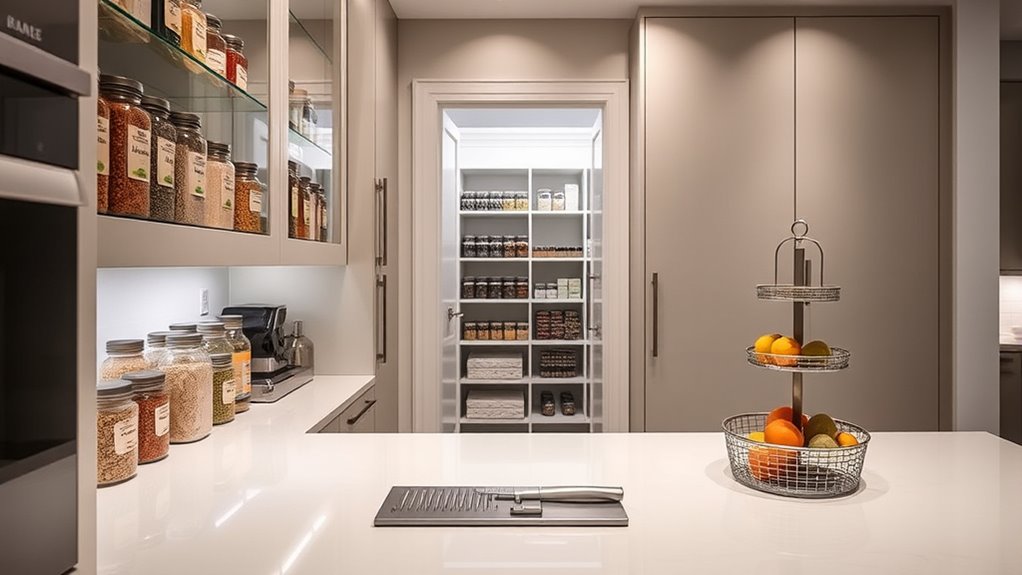
As you seek to enhance your kitchen's functionality, implementing smart storage solutions can make a significant difference.
Start by incorporating pull-out drawers for easy access to your kitchen items, reducing unnecessary bending. Larder cupboards can be customized for your baking or cooking needs, while toe kick drawers are perfect for stashing decorative plates. Additionally, consider adding a built-in spice organizer to keep your spices neatly arranged and easily accessible. To maximize your kitchen's efficiency, utilize hooks and wall organization to create a visually appealing and functional space.
Incorporate pull-out drawers and larder cupboards to enhance kitchen accessibility and organization, making cooking a breeze.
Maximize vertical space with pull-down shelves and narrow side shelves for extra storage. Utilize drawer dividers and stackable bins to keep your utensils and pantry organized.
Don't forget hidden spaces; under-sink storage and behind-the-door options can be game-changers.
Enhancing Efficiency and Accessibility
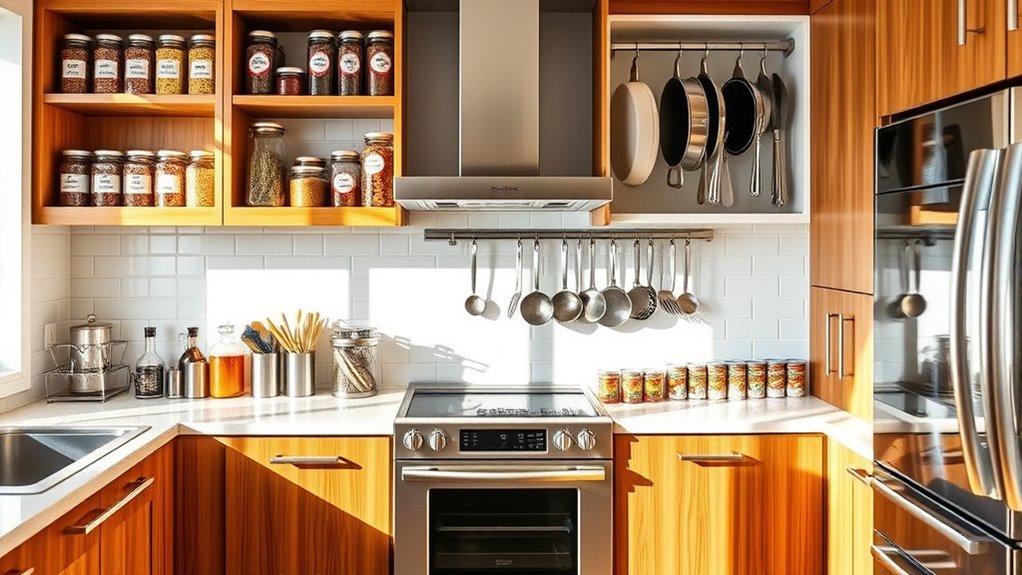
To create a kitchen that's both efficient and accessible, you'll want to focus on optimizing the layout and features. Ensure ample pathways of at least 36 inches for easy movement and consider open or U-shaped designs for better flow. Lower countertops to 30-34 inches for wheelchair users, or opt for adjustable height surfaces. Incorporating touchless faucets and lever handles makes daily tasks easier. Use under-cabinet lighting to brighten workspaces and select non-slip flooring to reduce accidents. Lastly, consider smart lighting systems for added convenience. Additionally, universal design principles ensure that your kitchen is usable for everyone without the need for adaptation. Furthermore, integrating smart home devices can enhance overall functionality and convenience in your kitchen.
Establishing Maintenance and Upkeep Routines

A well-organized kitchen not only boosts efficiency and accessibility but also requires consistent maintenance to keep it functioning optimally.
Establish daily routines like washing dishes, wiping countertops, and sweeping floors to prevent clutter. Clean as you cook by washing utensils and wiping spills to reduce later cleanup. Always maintain sink hygiene by rinsing dishes and wiping the sink after use. Tidy up countertops to ensure a clear workspace, as small daily actions lead to a cleaner kitchen. Additionally, ensure proper airflow around your cooking space to enhance air quality while preparing meals.
Establish daily cleaning routines to maintain a clutter-free kitchen and ensure a hygienic workspace.
Implement weekly deep cleaning tasks such as checking expired leftovers and wiping down appliances.
Create a monthly maintenance schedule to clean cabinet doors and check pantry inventories. Don't forget seasonal tasks like deep cleaning the refrigerator and organizing the pantry.
Adapting Your Organization System Over Time

While kitchen organization can feel like a one-time task, it's essential to adapt your system over time to meet changing needs. As your cooking habits or family dynamics evolve, reassess your storage solutions. Incorporate modular designs for flexibility, allowing you to adjust as necessary. Seasonal shifts may prompt you to rearrange items, like holiday dishes or summer cookware. An organized kitchen requires planning for efficiency and functionality. Regularly track your inventory to identify what needs replacing and declutter unused items to free up space. Group similar items together for easy access and consider labeling systems for clarity. Additionally, understanding your household energy consumption can help you optimize appliance placement for improved efficiency. Embrace new trends, such as smart devices and eco-friendly products, to enhance efficiency and support your lifestyle. Staying proactive ensures your kitchen remains organized and functional.
Creating a Kitchen That Supports Your Lifestyle
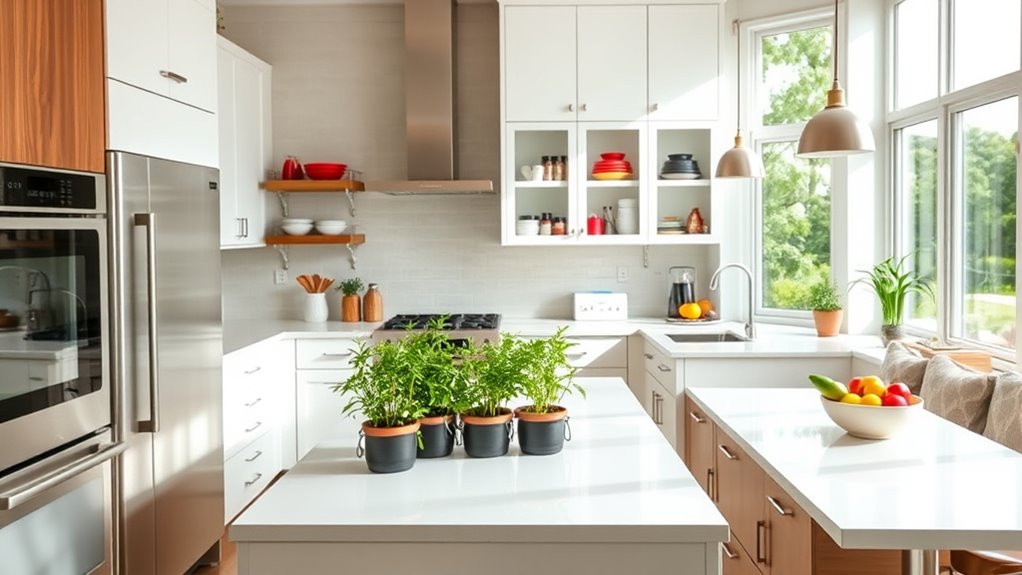
As your cooking habits and lifestyle evolve, creating a kitchen that aligns with your daily needs becomes increasingly important.
Start by applying the kitchen triangle principle to optimize movement between the sink, stove, and refrigerator. Divide your space into functional zones for cooking, prep, and storage, ensuring everything's easily accessible. Efficient storage solutions can significantly enhance the organization and accessibility of your kitchen items.
Consider a peninsula layout for efficiency and aesthetics, and use open shelving for quick access to frequently used items. Maximize storage with cabinet and drawer organizers, and employ stackable bins for pantry items.
Label everything to enhance identification and streamline your workflow. Lastly, regularly declutter and adapt your solutions to accommodate changes in your lifestyle, making your kitchen a true reflection of your needs and preferences.
Frequently Asked Questions
What Are the Best Materials for Kitchen Storage Solutions?
When choosing the best materials for your kitchen storage solutions, consider your needs.
Wood offers a classic, warm look but requires maintenance. Metal provides durability and a modern vibe. Plastic is affordable and versatile, but may not last as long. Glass adds elegance and transparency, while composite materials combine strength with aesthetic appeal.
Think about durability, maintenance, and sustainability to make the best choice for your kitchen's style and function.
How Can I Involve My Family in the Organizing Process?
Involving your family in the organizing process can be a fun and collaborative effort.
Start by assigning specific zones or tasks based on each person's interests and skills. Encourage everyone to share their ideas and preferences, making them feel invested in the outcome.
You can also set up kid-friendly spaces for younger members, teaching them responsibility. Regular check-ins will help maintain organization and keep everyone engaged in the kitchen's upkeep.
What Are Common Mistakes to Avoid When Organizing a Kitchen?
You don't want your kitchen to feel like a chaotic tornado hit it! To avoid common mistakes, steer clear of overcrowding your countertops and neglecting vertical space.
Group similar items together and create designated zones for specific tasks. Remember to declutter regularly and use airtight containers for food storage.
Don't forget to label everything, as confusion can quickly lead to frustration. Keeping it organized makes cooking a joy instead of a chore!
How Do I Maintain a Clutter-Free Kitchen Long-Term?
To maintain a clutter-free kitchen long-term, regularly assess your items and purge anything you haven't used in the past year.
Create specific zones for cooking, prep, and cleaning, ensuring frequently used items are easily accessible.
Schedule weekly cleaning sessions and check expiration dates on food.
Use uniform containers for storage and involve your family in keeping things organized.
Stay flexible, adapting your organization strategies as your needs change.
What Tools or Apps Can Help With Kitchen Organization?
Imagine your kitchen as a bustling city, where everything has its place. To keep this city thriving, you'll need some trusty tools.
Recipe organizer apps like Recify gather all your culinary treasures in one spot. Pantry management apps, such as KitchenPal, act like vigilant guards, tracking inventory and expiry dates.
Decluttering apps like Sortly help you streamline your space, while grocery list apps make shopping a breeze.
With these tools, your kitchen city can flourish!
Conclusion
Now that you've transformed your kitchen into a well-organized haven, imagine stepping into a space where every pot, pan, and spice jar sparkles with purpose. Picture whipping up your favorite meal with everything at your fingertips, effortlessly flowing from one cooking zone to another. With your new system in place, you'll not only enjoy the beauty of your kitchen but also the joy of cooking. Keep refining your space, and let it evolve with you and your lifestyle.
